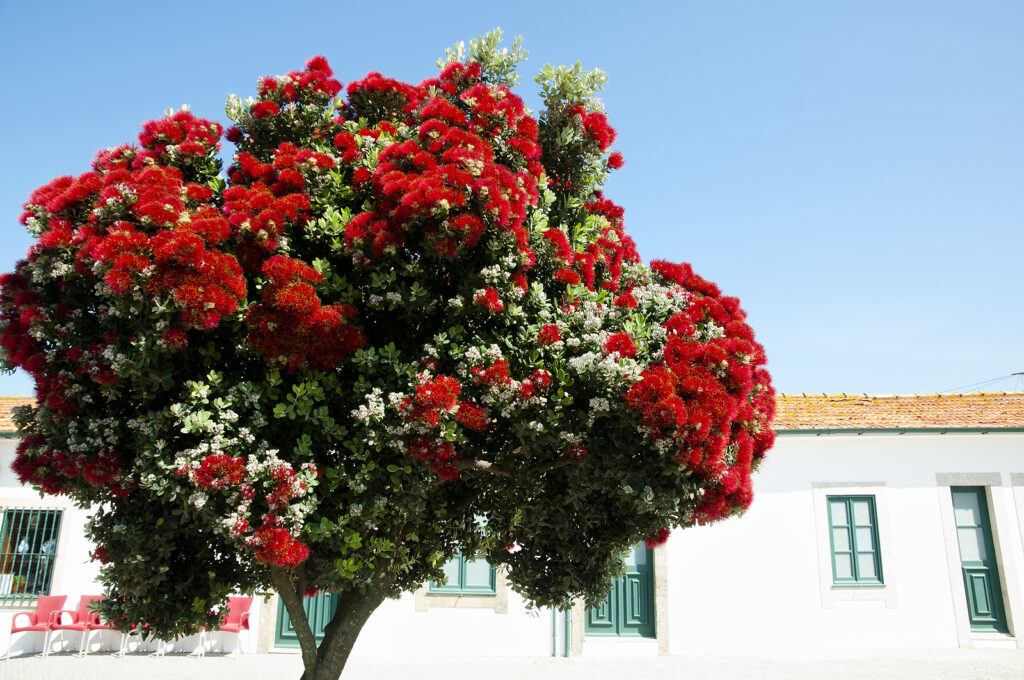Metrosideros–commonly known as New Zealand Christmas tree–is a subtropical tree or large shrub that bears colorful red flowers with many stamens from spring to early summer. Metrosideros is native to New Zealand.
Metrosideros can be grown as a specimen, hedge, or screen. It takes well to pruning and clipping. It can be planted on coastal sand dunes and cliffs; it tolerates salt spray and persistent wind once established. It is best grown in frost-free regions.
Metrosideros grows best with regular water; however, once established it will grow with just supplemental water.
Metrosideros is a genus of about 50 species of dwarf to tall, upright, evergreen shrubs and trees native to rainforests and river valleys from New Zealand to South Afric
Get to know Metrosideros
- Plant type: Evergreen dwarf to tall shrubs, trees
- Growing zones and range: Zones 9-15
- Hardiness: Hardy to Zone 9
- Height and width: 15 to 70 feet (20m) tall depending on the variety, 25-40 feet (8-12m) wide
- Foliage: Simple, leathery leaves borne in opposite pairs
- Flowers: Small, trumpet-shaped flowers with insignificant petals and brush-like tufts of stamens
- Bloom time: Spring through summer
- Uses: Specimen, hedge, screen
- Common name: New Zealand Christmas tree, Pohutakawa, Rata
- Botanical name: Metrosideros
- Family name: Myrtaceae
- Origin: Subalpine areas of New Zealand, South Africa to Malaysia, Australia, Pacific Islands

Where to plant Metrosideros
- Plant Metrosideros in full sun.
- Plant Metrosideros in humus-rich, moist but well-drained soil.
When to plant Metrosideros
- Set container-grown Metrosideros in the garden in spring or autumn.
Planting and spacing Metrosideros
- Space Metrosideros 25 to 40 feet (8-12m) apart.
How to water and feed Metrosideros
- Keep the soil just moist for optimal growth.
- Fertilize Metrosideros with a slow-release organic fertilizer in spring.
Metrosideros care
- Shelter young plants from cold, drying winds.
Metrosideros pests and diseases
- Scale insects may attack Metrosideros.
Metrosideros propagation
- Surface sow Metrosideros seed in spring.
- Root semi-ripe cuttings with bottom heat in summer.
- Metrosideros can be air-layered in spring.
Metrosideros varieties to grow
- Metrosideros excelsus, Christmas tree. Erect, freely benching tree, spreading with age; elliptic leaves yo 4 inches, semi-glossy, dark green above, densely white-felted beneath; many-flowered cymes with crimson filaments and golden anthers; grows to 15-20 feet tall and almost as wide.
- M. kermadecensis. Bushy, rounded tree to 70 feet tall and 40 feet wide; ovate dark green leaves; flowers on dense cymes with crimson filaments and yellow anthers.
- M. robustus, New Zealand Christmas tree. Freely branching tree, spreading with age; grows to 100 feet tall and 40 feet wide; semi-glossy, dark green leaves; summer flowers with crimson filaments and yellow anthers on dense, terminal cymes.















